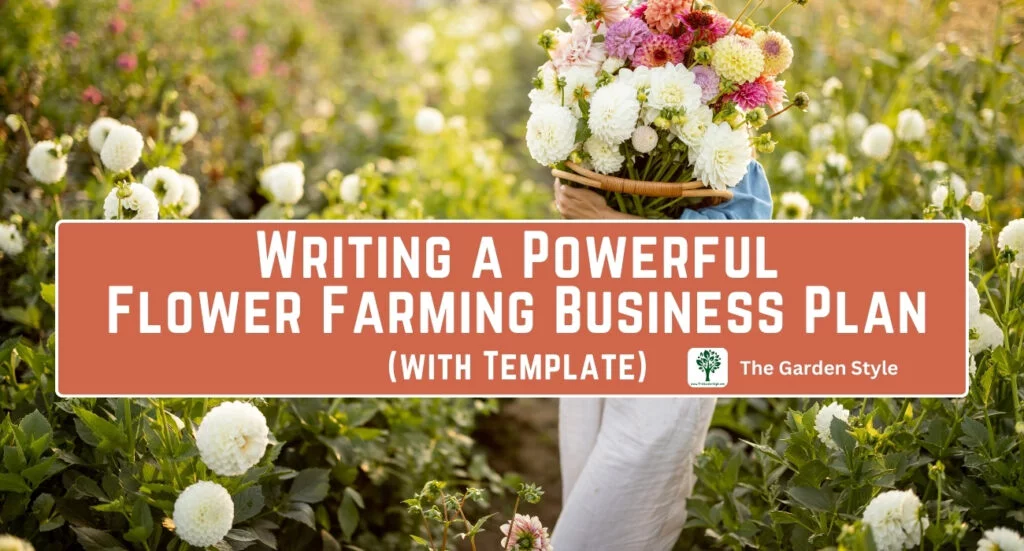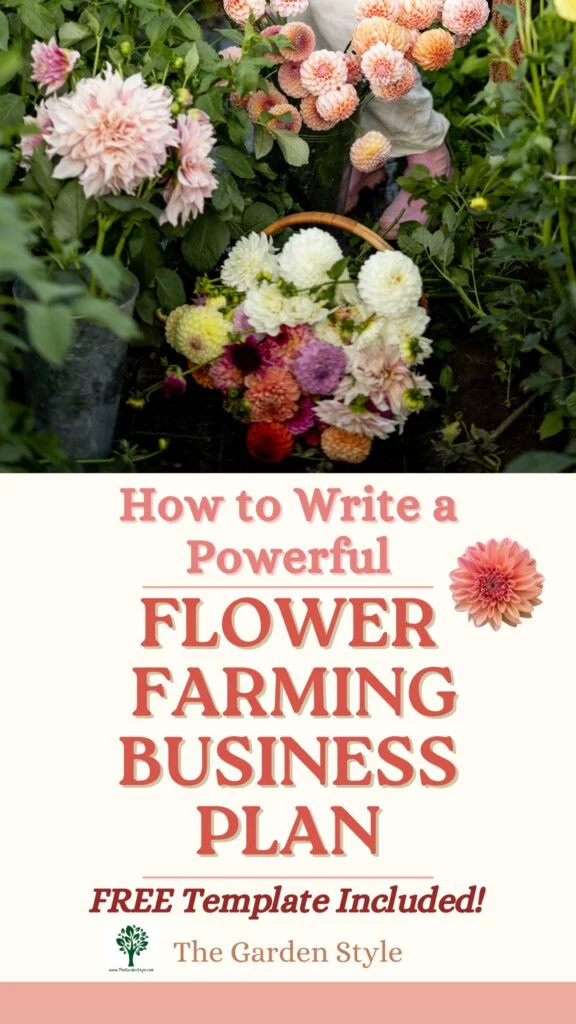Are you dreaming of turning your passion for growing beautiful flowers into a thriving business? Starting a successful cut flower farm requires meticulous planning and preparation. One of the most important first steps is creating a comprehensive and powerful flower farming business plan. In this post, I will guide you in writing yours.
A flower farm business plan is a strategic document that outlines every aspect of your intended business operations. It serves as a roadmap for executing your vision, validating your ideas with research, and forecasting finances to ensure profitability. Think of it as the blueprint for building your cut flower enterprise from the seed up.
Having a well-crafted business plan for your cut flower business is crucial for several reasons:
- Solidifying your plans and strategies on paper
- Conducting due diligence on the market and competition
- Identifying potential challenges and risk mitigation tactics
- Determining capital requirements and financing needs
- Attracting investors, partners, or funds if needed
- Guiding execution and measuring performance once launched
Whether you’re just sowing the seeds of your flower farming dreams or ready to turn an existing hobby into a full-fledged business, crafting a business plan is vital. To help you grow, we’ve put together the ultimate template to guide you through all the key components. Before diving into the cut flower farm business plan template pdf, let’s start by explaining what a cut flower business plan is and why you need one.
Table of Contents
What Is a Flower Farm Business Plan?
A flower farm business plan is a comprehensive document that outlines the operational and financial strategy for a commercial cut flower growing operation. It serves as a blueprint for starting, running, and expanding a flower farming business profitably.
The key components of a flower farm business plan typically include:
- Executive summary of the business
- Company overview (location, legal structure, team, assets)
- Market analysis of the floral industry and target customers
- Detailed descriptions of flower products/services and pricing
- Production and growing plans (crop varieties, acreage, techniques)
- Sales and marketing strategies (channels, branding, promotions)
- Operating plan (facilities, equipment, staffing, processes)
- Financial projections and startup/operating budgets
- Potential challenges/risks and mitigation strategies

Why Do I Need a Flower Farm Business Plan Before Starting a Cut Flower Farm?
There are several crucial reasons why you need a well-crafted business plan before launching a commercial cut flower farming venture:
- Internal Planning: It forces you to thoroughly research and think through all aspects of your farm’s operations, from production logistics to sales and finances. This upfront planning increases your chances of success.
- Securing Funding: A solid plan demonstrates to potential lenders or investors that you have a viable, profitable business model backed by market validation and financial forecasts.
- Roadmap for Execution: The plan serves as a comprehensive guide for managing cash flow, implementing growing plans, executing marketing tactics, and measuring performance against goals.
- Attracting Talent/Partners: It can be used to recruit experienced staff and advisors or forge partnerships by showcasing your farm’s mission, expertise, and growth potential.
- Legal/Regulatory Compliance: Agricultural businesses (such as flower farms) often require operating licenses and permits and must follow zoning and environmental regulations, which may require formal planning documentation.
Starting a successful flower farming business is not without its challenges, and that’s when our flower farming business plan template will guide you in navigating those obstacles.
Ultimately, a flower farm business plan is an essential tool that forces strategic foresight rather than operating by chance. It lends credibility, identifies challenges upfront, and provides a structured pathway for establishing a sustainable, profitable flower-farming enterprise.
Last but not least, ensure you meticulously identify and claim all eligible deductions for flower farming. This will enable you to retain a greater portion of your well-deserved earnings from the fruits of your labor. I recommend reading my article about Maximizing Tax Deductions for Flower Farming Businesses to explore more than 100 potential deductible expenses when growing cut flowers as a business (whether you’re growing in your backyard or have a flower farm).
Recommended reading: How to Start a Cut Flower Garden: Plan and Layout
Flower Farming Business Plan Template
Here is our comprehensive flower farming business plan template, accompanied by concise explanations for each section, to help you craft a compelling and well-structured plan for your blossoming floral enterprise.
1. Executive Summary
Brief overview of your flower farm business
Provide a concise summary of your flower farming operation.
Products/services offered
List the products like cut flowers, herbs, and produce and services like bouquets, CSAs, and events that you plan to offer.
Target customers
Describe your ideal customer segments and demographics.
Future vision and growth plans
Outline your long-term aspirations and strategic growth initiatives for the business.
SWOT
A SWOT analysis is a strategic planning tool that evaluates the Strengths, Weaknesses, Opportunities, and Threats of a business or project. Learn How to Do a SWOT Analysis.
2. Company Description
Business name, address, and contact information
State the official business name, location, website, email, and phone number.
Principal members and their qualifications/experience
Introduce the key owners/founders and highlight relevant backgrounds.
Legal structure
e.g., sole proprietorship, LLC, etc. Specify the legal entity your business will operate as.
Company details
Property zoning, existing infrastructure, plans for expansion) (Describe zoning, land, facilities, and future expansion plans.
Human resources plan
Outline staffing needs and plans as the business grows.
List of farm assets
Provide an inventory of current assets like equipment, vehicles, and supplies.
3. Market Research
Industry overview and trends
Discuss the flower farming industry landscape, market size, and forecasts.
Relevant regulations and licensing requirements
List the licenses, permits, and certifications needed to operate legally.
4. Product/Service Line
Detailed description of products/services offered
Thoroughly describe each product, such as bouquets, seeds, tubers, bulbs, corms, merchandise (such as t-shirts and hoodies, if you intend to have a brand), and service-like events (tours, agritourism, photography sessions, wedding sessions, or services for celebrations, showers, gift cards, flower bouquet coupons, etc.).
Pricing structure
Explain your pricing model and strategy for each offering.
5. Marketing and Sales
Marketing strategies
Marketing strategies, including social media, agritourism, networking, etc. Outline your promotional tactics.
Sales channels
Sales channels could be farming stands, farmers’ markets, CSA, local businesses, etc. List the avenues for selling products/services.
Five-year business development plan
Provide a phased growth plan for the next 5 years
6. Financial Projections
Start-up costs
Estimate one-time costs for launching, like equipment, licenses, and inventory.
Operating expenses
Project ongoing costs for labor, supplies, utilities, insurance, etc.
Revenue forecasts
Forecast potential sales and income over 3-5 years.
Break-even analysis
Calculate the sales volume required to cover all expenses.
Financing needs
Determine funding needed and sources like loans, investors, etc.
7. Appendices
Supporting documents
e.g., market research data, financial statements, etc. Include key documentation.
List of potential suppliers and vendors
Identify companies from which to source supplies and services.
Tax and legal considerations specific to your business
Discuss tax and legal factors relevant to your operations.
Sign Up and Download your Flower Farming Business Plan Template PDF
Save your pin for later and learn how to write a flower farming business plan. Download your free template pdf to write your cut flower business plan easily.


